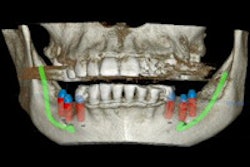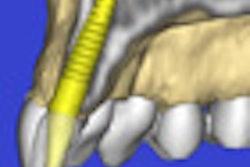
Researchers evaluated consensus guidelines published in major implant dentistry journals and found that methodological improvement is needed, according to a new study.
The authors said that would buoy the quality and trust of information needed to make proper clinical decisions, and they recommended adherence to high and transparent standards.
"It is time to move forward to improve the quality of clinical guidelines, which can provide a bridge between evidence and its applicability," they wrote in a study in PLOS One (January 20, 2017). "The concept of developing consensus guidelines without a robust methodology is a remnant from the "pre-evidence-based era."
The authors were led by Clovis Mariano Faggion Jr., DMD, an associate professor of periodontology and operative dentistry at the University of Münster in Germany. His co-authors were from Cayetano Heredia Peruvian University in Lima and the University of Würzburg in Germany.
Room for improvement
Since consensus guidelines are useful for improving clinical decision-making, their methodological evaluation is highly important, the authors explained.
“The concept of developing consensus guidelines without a robust methodology is a remnant from the 'pre-evidence-based' era.”
The developers of consensus guidelines make clinical practice recommendations based on the best available evidence, which can include well-conducted systematic reviews. Consensus guidelines often are created by leading experts in particular fields who meet in person to reach consensus in generating these recommendations.
The researchers of the current study sought to evaluate the methodological quality and transparency of development of consensus guidelines published in highly ranked implant dentistry journals, as well as to see if including systematic reviews conducted to support these guidelines improved methodological quality. To do so, they used the Appraisal of Guidelines Research and Evaluation II (AGREE II) tool. The current and previous versions have been used to evaluate the quality of guidelines in various medical disciplines.
They evaluated all consensus guidelines, 27 in total, published since 2009 in six major implant dentistry journals:
- Clinical Oral Implants Research
- Clinical Implant Dentistry and Related Research
- European Journal of Oral Implants
- International Journal of Oral and Maxillofacial Implants, Journal of Oral Implantology
- Implant Dentistry
The researchers independently applied AGREE II to the consensus guidelines. AGREE II is composed of six domains, each of which include between two and eight items. Each of the domains received a median percentage score.
Afterward, they conducted another AGREE II analysis that also included 22 systematic reviews supporting 22 of the consensus guidelines.
Items considered for each of the domains included the following:
- Domain 1 (scope and purpose): "The overall objective(s) of the guideline is (are) specifically described."
- Domain 2 (stakeholder involvement): "The views and preferences of the target population (patients, public, etc.) have been sought."
- Domain 3 (rigor of development): "Systematic methods were used to search for evidence," "The health benefits, side effects, and risks have been considered in formulating the recommendations," and "The guideline has been externally reviewed by experts prior to its publication."
- Domain 4 (clarity of presentation): "The different options for management of the condition or health issue are clearly presented."
- Domain 5 (applicability): "The guideline describes facilitators and barriers to its application," and "The potential resource implications of applying the recommendations have been considered."
- Domain 6 (editorial independence): "The views of the funding body have not influenced the content of the guideline," and "Competing interests of guideline development group members have been recorded and addressed."
| Median scores by domain | ||
| Domain | Consensus guidelines (n = 27) |
Consensus guidelines + systematic reviews (n = 49) |
| Domain 1 (scope and purpose) | 69.4 | 84.7 |
| Domain 2 (stakeholder involvement) | 41.7 | 50 |
| Domain 3 (rigor of development) | 30.7 | 56.3 |
| Domain 4 (clarity of presentation) | 75 | 76.4 |
| Domain 5 (applicability) | 26 | 26 |
| Domain 6 (editorial independence) | 41.7 | 79.2 |
"This study showed that there is room for improving the methodological quality of consensus guidelines in implant dentistry," Dr. Faggion told DrBicuspid.com. "The present findings may serve as 'baseline' information for further development of consensus guidelines with a more robust methodological approach."
The researchers also found great variability in quality among the consensus guidelines, the authors reported. The results provide information about which domains should be prioritized in the development of future implant dentistry guidelines, they noted.
Scores for domain 5 (applicability) were lowest with and without the inclusion of systematic reviews, while domain 3 (rigor of development), which more directly reflects the methodological aspects of the guidelines, and domain 2 (stakeholder involvement) also were low for both analyses.
"Patients' views are pivotal in gaining an understanding of their needs, and future guidelines in implant dentistry should include more information from patients' perspectives," the authors wrote.
Due to the significant improvement in all domain scores achieved by the inclusion of systematic reviews, they recommended that users of the consensus guidelines examine both types of material.
Evidence-based era
This is the first study to evaluate the methodological quality of consensus guidelines published in highly ranked implant dentistry journals using a validated tool, according to the authors.
However, they acknowledged study limitations, including that adequate sample size was difficult to assess and their sample of guidelines is arguably small.
Nevertheless, they pointed to the robust and significant improvement in scores with the inclusion of data from systematic reviews. Similar results would likely be obtained with a larger sample, they wrote. They suggested a reduction in the methodological gap between well-developed systematic reviews and clinical practice guidelines, and that other types of guidelines in implant dentistry be evaluated with AGREE II in the future.
"The findings of the present study may help researchers to better develop consensus guidelines in implant dentistry, which will improve the quality and trust of information needed to make proper clinical decisions," the authors concluded.



















